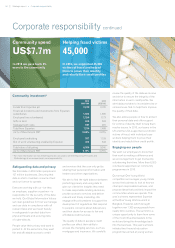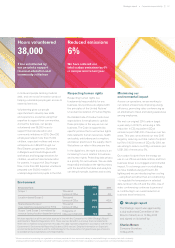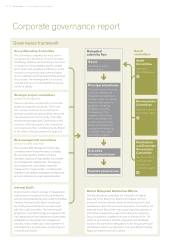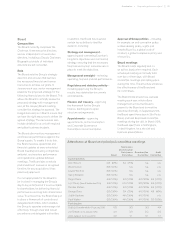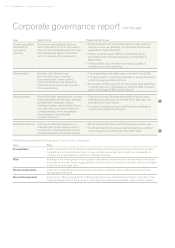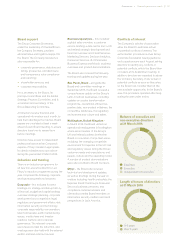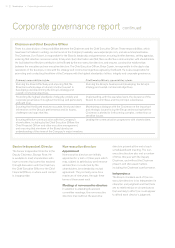Experian 2016 Annual Report Download - page 63
Download and view the complete annual report
Please find page 63 of the 2016 Experian annual report below. You can navigate through the pages in the report by either clicking on the pages listed below, or by using the keyword search tool below to find specific information within the annual report.
The main principles of the
UK Corporate Governance Code
How Experian has applied the principle
Section B: Effectiveness (continued)
B.5 Information and support: The board should be
supplied in a timely manner with information in
a form and of a quality appropriate to enable it to
discharge its duties.
The Company Secretary and his team use the latest technology to deliver
clear and relevant materials to all Board members, far enough in advance
of meetings to allow sufficient preparation. The format and content of
papers is monitored on an ongoing basis, to allow for improvement
where necessary.
B.6 Evaluation: The board should undertake a
formal and rigorous annual evaluation of its own
performance and that of its committees and
individual directors.
The internal evaluation undertaken during the year is described later, and
was well received by the Board. Next year’s evaluation will be facilitated
externally, and the Board will consider this during 2016, including who the
Board should ask to run the process for the maximum benefit.
B.7 Re-election: All directors should be submitted for
re-election at regular intervals, subject to continued
satisfactory performance.
In line with the UK Corporate Governance Code, all Experian directors
are subject to annual election or re-election. The only exception for 2016
is Judith Sprieser, who will not stand for re-election and will step down at
the AGM. Directors are only recommended for election or re-election on
completion of their individual performance evaluations.
Section C: Accountability
C.1 Financial and business reporting: The
board should present a fair, balanced and
understandable assessment of the company’s
position and prospects.
This Annual Report contains all disclosures required under applicable
laws and regulations, as well as many others that are included on a
voluntary basis. The Board has put in place a rigorous process to ensure
that the Annual Report (and the half-yearly financial report) are fair,
balanced and understandable. This process is described later.
C.2 Risk management and internal control: The
board is responsible for determining the nature
and extent of the principal risks it is willing to take
in achieving its strategic objectives. The board
should maintain sound risk management and
internal control systems.
During the year, the Board and the Audit Committee reviewed and
approved risk appetite statements for the Group. These important
statements will assist the Board and the Audit Committee to manage the
Group’s principal risks. Risk metrics underpinning the statements will be
included within the internal reporting cycle.
C.3 Audit Committee and auditors: The board should
establish formal and transparent arrangements for
considering how they should apply the corporate
reporting, risk management and internal control
principles and for maintaining an appropriate
relationship with the auditors.
These responsibilities are delegated to the Audit Committee by the Board,
and the Committee’s agendas (which align with the Group’s reporting
cycle) include updates on material issues relevant to corporate reporting,
risk management and internal control. The Committee ensures that there
is an appropriate relationship with the auditor and this is currently high
on the Committee’s list of priorities, given the transition to KPMG LLP in
respect of the audit for the year ending 31 March 2017.
Section D: Remuneration
D.1 The level and components of remuneration:
Executive directors’ remuneration should be
designed to promote the long-term success of the
company. Performance-related elements should be
transparent, stretching and rigorously applied.
The Report on directors’ remuneration outlines the way in which the
Group applies this principle.
D.2 Procedure: There should be a formal and
transparent procedure for developing policy
on executive remuneration and for fixing the
remuneration packages of individual directors.
No director should be involved in deciding his or
her own remuneration.
These procedures are in place, and the Report on directors’ remuneration
which follows the Corporate governance report contains relevant details.
Section E: Relations with shareholders
E.1 Dialogue with shareholders: There should be a
dialogue with shareholders based on the mutual
understanding of objectives. The board as a whole
has responsibility for ensuring that a satisfactory
dialogue with shareholders takes place.
The Board is available to meet shareholders on matters such as strategy,
remuneration and governance.
E.2 Constructive use of general meetings: The board
should use general meetings to communicate with
investors and to encourage their participation.
All Board members attend the AGM and are available to meet informally
with shareholders who attend, before the meeting starts. We know that
shareholders who attend value this opportunity to meet the directors.
61Governance •UK Corporate Governance Code







